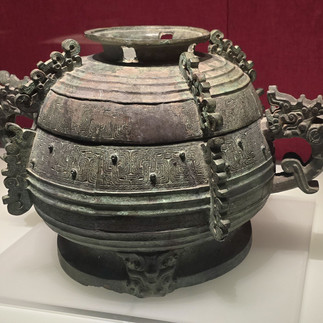Henan Museum - The Vault of China
- Shannon
- May 8
- 5 min read
Updated: Jul 30
Fragments from Forgotten Empires
In the heart of Zhengzhou, the capital of China’s Henan Province, stands a structure that quietly guards the soul of a civilisation, the Henan Museum. With its soaring, bronze coloured dome echoing the shape of an ancient Chinese cauldron, the museum is not just a building, it’s a portal to one of the oldest and most culturally rich regions in China. Here, the spirit of one of the world’s oldest civilizations lingers in every artifact, whispering stories from millennia ago. Spanning more than 10000 square metres, the museum is home to over 130,000 relics that span over 8000 years.

Often called the "cradle of Chinese civilization," Henan was once home to several ancient rulers. Over the course of 3 millennia, dynasties like the Shang, Zhou, Han, Tang and Song left their mark on this land, rising, ruling and fading into history. At the Henan Museum, their legacies aren’t told in words but in extraordinary antiquities unearthed from the earth itself, bronze, jade, pottery and bone, each piece echoing the lives and empires that shaped China’s story.
The original museum was founded in 1927, one of the earliest museums established by Chinese scholars, to preserve their heritage amid political upheaval and foreign invasions. In its early days, the museum’s collections were hidden and moved multiple times to escape looting during the Second Sino-Japanese War and later the Chinese Civil War. By the late 20th century, it found its permanent home in a modern, purpose-built facility, becoming one of China’s most prestigious historical museums.

The pottery vases and animal ornaments at the Henan Museum reflect a rich blend of daily life, artistry and spiritual belief in ancient China. From the hand painted vessels of the Neolithic Yangshao culture to the refined, glazed forms of later dynasties, these vases served both practical and ceremonial roles, used for storing food and drink or accompanying the dead in burial as symbols of abundance. Animal ornaments, crafted from pottery, jade or bronze, depict creatures like tigers, dragons, horses and birds, often acting as spiritual protectors or totems.

Often described as The Vault of China, the Henan Museum stands as a monumental tribute to the nation’s deep and layered past
The bronze bowls and vases at the Henan Museum are masterpieces of ancient Chinese craftsmanship, dating back to the Shang and Zhou dynasties. Far more than decorative items, these vessels played a central role in ritual ceremonies and ancestor worship, symbolizing power, prestige and spiritual connection. Made using an advanced piece-mold casting technique, they feature intricate designs, mythical beasts, geometric patterns and early script that reflect the artistry and beliefs of their time. Many were unearthed from royal tombs and ceremonial sites in Henan, a region rich in cultural legacy.
Jade funeral suits from the Han dynasty are among the most awe inspiring artifacts in the Henan Museum. Composed of thousands of meticulously cut jade tiles, each suit was sewn together with threads of gold or silver, intended to shield the body and preserve the spirit for eternity. Once reserved for royalty and high ranking nobles, these suits embodied deep-rooted beliefs in immortality and the afterlife, a silent testament to ancient China’s reverence for death and the souls journey beyond.

The Wang Sun Gao Chimes, dating back to 770BC, are a stunning set of 26 bronze bells unearthed in Xichuan County. They are notable for their double-tone design, each bell produces two distinct pitches, spanning over four octaves. Commissioned by nobleman Wang Sun Gao of the Chu state, the chimes reflect the ceremonial importance of music in ancient China and showcase the era's advanced craftsmanship in both metallurgy and musical theory.
The 2000 year old green and yellow figurines in the Henan Museum are typically made from terracotta or stoneware and are exceptional examples of Han dynasty craftsmanship. Often brightly colored in shades of green, yellow and other earthy tones, these figurines were not only aesthetically striking but also carried significant cultural meaning. Most commonly found in tombs, they were believed to serve as companions or protectors for the deceased in the afterlife.
Human figurines represented figures such as servants, musicians and warriors, while animal figurines depicted creatures like horses, camels and mythical beasts, reflecting both the material and spiritual worlds. The use of green and yellow was symbolic, with yellow often associated with imperial power and the emperor, while the overall colour scheme suggested life, fertility and renewal. These figurines offer a glimpse into Han dynasty beliefs and artistic expression, emphasising the importance of status and continuity in the afterlife.

The bone flutes from Jiahu and oracle bones from Anyang are two of the Henan Museum's most extraordinary artifacts, offering a glimpse into the origins of Chinese music and writing. Over 8,000 years old, the Jiahu flutes, carved from crane bones, are the oldest known playable instruments, revealing early musical skill and ritual use. In contrast, the oracle bones from the Shang dynasty, etched with ancient scripts describing of battles, harvests and celestial events, were used in divination rituals to communicate with ancestors.

As visitors walk the stone halls of the Henan Museum, they pass not just through centuries, but into the minds and lives of people who lived before dynasties were born. The museum doesn’t just showcase artefacts, it reveals how the heart of China pulsed with innovation, spirituality, conflict and culture. In many ways, the museum itself is a living relic, born of a desire to protect what is fragile, strengthened by war and now standing firm as a custodian of identity. Through war, flood, political change and modernity, it has preserved the voices of emperors and commoners alike.
The Henan Museum is a bridge across time. Within its walls, ancient bones and bronze speak of humanity’s enduring quest to understand life, death, the cosmos and the self. And in a world that moves too fast, it invites us to pause and listen to the long, quiet story of a civilization still unfolding.
🗺️ Location
8 Nongye Road, Jinshui District, Henan Province, Zhengzhou City, China
🚆 How to get there
The Henan Museum is easily accessible from central Zhengzhou. You can take Metro Line 2 to Guanhutun Station (Exit C) and walk about 800 meters to the museum. Several bus routes, including B102, B11, B18, and B2, stop directly at Bowuyuan BRT Station, right by the entrance. A taxi from the city center takes around 15 - 20 minutes and typically costs ¥25 - ¥30.
⭐ Attraction Info
The museum is open everyday between 9am - 5pm from Tuesday to Sunday and is closed every Monday except for national holidays. Last admissions are at 4pm. Entry is free of charge however reservations must be booked in advance via Henan Museum's official WeChat account. You will need your passport to confirm your booking.

















































































